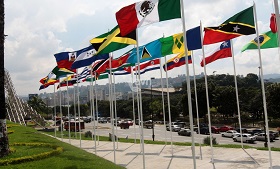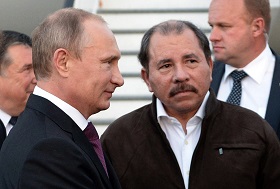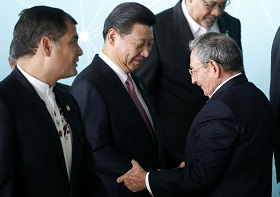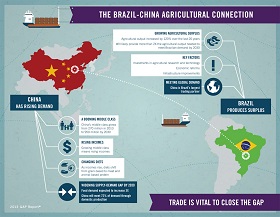Due to the Ukrainian crisis and the ensuing economic and trade conflict between Russia and the West, Moscow’s interests in Latin America go beyond the scope of geopolitics and ideology to include the search for new suppliers of food products supplied from this region. These developments offer hope for the establishment of effective and pragmatic mechanisms for strategic cooperation between Russia and the region.
Following the Ukrainian crisis, the system of international relations has undergone dramatic changes, with far-reaching consequences already becoming clear. One such consequence of the pressure that the West has put on to isolate Russia is the need to expand political contacts or “synchronize watches” with close friends and allies, to quote Russian Foreign Minister Sergei Lavrov [1].
This geopolitical goal has been achieved in Latin America – a continent traditionally friendly to Russia and situated in close proximity to the United States whose control over the region has weakened. In May 2014, Sergei Lavrov paid a visit to Cuba, Nicaragua, Chile and Peru. It is worth noting that the first two countries (along with their ALBA left-radical partners Venezuela and Bolivia) share Moscow’s position on Crimea, while Chile and Peru voted for the UN General Assembly’s Resolution on the territorial integrity of Ukraine in March 2014. The UN resolution was also supported by Colombia, Mexico, Panama, Costa Rica, Guatemala, Honduras and the Dominican Republic, while Brazil, Argentina, Uruguay, Ecuador, Paraguay and El Salvador abstained from voting [2].
In July 2014 Russian President Vladimir Putin made a trip to Cuba, Nicaragua, Argentina and Brazil, where he attended the 6th BRICS Summit .
Another and, perhaps, more urgent problem for Moscow, caused by the Ukrainian crisis and requiring an immediate solution, is the need to find new business partners and suppliers of food products for the Russian market following the food embargo imposed by Vladimir Putin’s government on those countries which joined sanctions against Russia [3].
We can assume that if the Kremlin had a strategic vision for Latin America as a long-term partner, it was mostly in ideological and geopolitical terms, rather that trade and economic ones. This new vision has shaped our relationship, especially during moments of growing tension with the West. This explains the closer cooperation with the countries of the “anti-American” Bolivarian Alliance for the Peoples of Our America (Alianza Bolivariana para los Pueblos de Nuestra América, ALBA), which includes Cuba, Venezuela, Nicaragua, Ecuador, Bolivia, as well as the small island states of Dominica, Saint Vincent and the Grenadines, Antigua and Barbuda, and St. Lucia.
The dominant role for pragmatism and commercial interests within cooperation has become a new aspect of our relationship, which may dramatically alter the picture and make Latin America a priority for Russian foreign policy. The situation is also quite delicate, but definitely encourages optimism in those who have long talked about Russia and Latin America as natural allies and have insisted on the importance of increased cooperation.
Time to Return
Although the issue of Russia’s “return” to Latin America has been discussed for quite a long time, this region until recently has not been on the priority list for the Kremlin's foreign policy. Despite the growing geopolitical importance of the region, the prospects for mutually beneficial trade and economic cooperation, based on the sustained economic growth of the Community of Latin American and Caribbean States (CELAC) [4] as well as ambitious infrastructural projects in a number of Latin American countries (in which Russian technologies could be useful), Russia’s efforts in this area have not been sufficiently active in recent years [5]. Moreover, the positive experience of cooperation between Latin America and the Soviet Union, the recollection of which has not disappeared, could give Russia a competitive edge.
Meanwhile, numerous studies and the experiences of other countries, namely China [6], Japan [7] and South Korea [8], as well as the European Union [9], testify to the great opportunities offered by cooperation with Latin America.
A number of Russian companies are successfully operating in the region, primarily in the sphere of military-technical cooperation and in the energy sector, namely in Brazil, Argentina, and Venezuela. However, their presence in a number of cases is largely due to a powerful political lobby, for example, Vladimir Putin’s friendship with Hugo Chavez. This, undoubtedly, is an effective way to “enter the market,” but sustainable and universal mechanisms of cooperation cannot be created without strategic and long-term interests, which would help reduce risks to investments should governments change in the host country [10].
Competitors Never Sleep
Meanwhile, potential competitors for Russian are consistently and strategically developing mechanisms for cooperation with Latin America. The EU is second only to the United States in terms of trade with the region. During the first decade of the 21st century, CELAC-EU trade turnover has more than doubled, reaching 202 billion euros. In 2012, the EU signed a number of agreements on free trade with regional integration blocs, namely Central America and the Andean Community of Nations (Comunidad Andina, CAN), while negotiations on signing an agreement with the Common Market of the Southern Cone (Mercado Común del Sur, Mercosur) have been underway since 2010.
During the first decade of the 21st century, China has become the third largest trading partner of Latin America after the United States and the EU [11], and in the coming years, according to forecasts, will likely to challenge the EU [12]. The growth rate of exports from CELAC to China in 2006-2010 was more than five times higher than the corresponding world average [13]. In 2012, the volume of CELAC exports to China amounted to 130.9 billion dollars.
From 2005 to 2013, China accommodated Latin American countries with loans worth 102 billion dollars [14], and in July 2014 announced the creation of a new $35 billion fund to finance infrastructure projects in the country-members of the Community of Latin American and Caribbean States (Comunidad de Estados Latinoamericanos y Caribeños, CELAC) [15].
Russia obviously lags behind its main competitors in promoting trade and economic relations with CELAC. Currently there are only three Russian trade missions in CELAC countries: Argentina, Nicaragua, and Brazil [16]. The elements of “soft power,” economic diplomacy, informational support for international activities, and Russian Centers of Science and Culture, all of which could contribute to shaping a positive image for the country, should not be underestimated in this regard.
Blessing in Disguise
In response to the sanctions imposed on Russia, on August 6, 2014 Vladimir Putin signed a decree forbidding or limiting for one year “economic transactions providing the import on the territory of the Russian Federation of separate types of agricultural products, raw materials and the food which country of source is a state that made a decision to introduce economic sanctions” against Russia [17]. It was decided to make up for prohibited deliveries by obtaining supplies from other producers, including Latin American countries, in particular Ecuador, Chile, Brazil, and Argentina. This measure opens up an unprecedented opportunity for countries in the region to gain access to new markets and significantly increase their trade with Russia. And Moscow gets a real chance to diversify deliveries and create universal mechanisms of cooperation, which will open up new prospects for companies interested in trade with CELAC.
Furthermore, we cannot rule out that the anti-Russian sanctions and manifestations of Western unilateralism have added fuel to the fire and provoked the adoption of ambitious decisions during the BRICS Summit in Brazil in July 2014, most notably concerning the global financial architecture, which is one of the most painful issues for the West. Brazil, Russia, India, China and South Africa agreed to establish the BRICS Bank, which may seriously challenge the IMF and the World Bank, which are controlled by the traditional Western centers of power.
How long will the sanctions war last? Taking into consideration the fact that they are inflicting damage on both sides of the conflict, we can assume that the reciprocal sanctions are likely to be lifted in the near future. Meanwhile, the offer made by Moscow to Latin America producers is serious and not limited in its duration. There is every reason to believe that these producers will not forego this opportunity. This means that after lifting the embargo, traditional suppliers will have a hard furrow to plow, as Vladimir Putin has already warned [18].
They will have to compete head-to-head for the attractive Russian market, and in this competition, Latin America, being the “world food pantry,” may enjoy significant advantages, such as strong export positions against the background of rising global food prices, as well as growing demand for organic food, the production of which the region has put an emphasis on for some time.
1. Tovarishha Lavrova prinjali v nikaraguanskuju sem'ju // http://www.kommersant.ru/doc/2464430
2. Naciones Unidas denuncia la “anexión” rusa de Crimea // http://www.elnuevoherald.com/2014/03/27/1712657/naciones-unidas-denuncia-la-anexion.html
3. Presidential Decree of the Russian Federation from August 6, 2014 “About application of separate special economic measures for the purpose of the security of the Russian Federation” http://kremlin.ru/news/46404
4. According to the UN Economic Commission for Latin America and the Caribbean (ECLAC), starting from 2003, economic growth in CELAC was higher than in the European Union: 4.6 per cent in 2003-2008 ; 6 per cent in 2010; 4.3 per cent in 2011; 3.1 per cent in 2012; 4.1 per cent in 2013-2016. For details see: La Unión Europea y América Latina y el Caribe: Inversiones para el crecimiento, la inclusión social y la sostenibilidad ambiental. CEPAL. SantiagodeChile, 2013. P. 22. //
5. Sergej Rjabkov: Latinskaja Amerika trebuet osobogo podhoda// http://interaffairs.ru/read.php?item=8263
6. Las cinco principales inversiones de China en América Latina // http://www.bbc.co.uk/mundo/noticias/2014/05/140428_china_
america_latina_inversiones_lp.shtml
7. http://www.cepal.org/publicaciones/xml/5/40695/Cooperacion_relaciones_entre_
Japon_America_Latina_Capitulo_V_vf.pdf
8. América Latina es el socio regional más dinámico para Corea del Sur // http://www.caf.com/es/actualidad/noticias/2012/09/america-latina-es-el-socio-regional-mas-dinamico-para-corea-del-sur
9. La Unión Europea y América Latina y el Caribe: Inversiones para el crecimiento, la inclusión social y la sostenibilidad ambiental http://www.cepal.org/publicaciones/xml/0/48080/UnionEuropeaRev1.pdf
10. Smena vlasti v Venesujele ugrozhaet rossijskim investicijam? // http://www.vestifinance.ru/videos/8277
11. Osvaldo Rosales, Mikio Kuwayama: China y América Latina y el Caribe: Hacia una relación económica y comercial estratégica. CEPAL.Santiago, 2012.
12. La República Popular China y América Latina y el Caribe: Hacia una nueva fase en el vínculo económico y comercial. CEPAL. Santiago de Chile, 2011. P. 15.
13. Ibid.
14. Las cinco principales inversiones de China en América Latina // http://www.bbc.co.uk/mundo/noticias/2014/05/140428_china_america_latina_inversiones_lp.shtml
15. China ofrece 35.0000 millones de dólares para proyectos en Latinoamérica // http://www.infolatam.com/2014/07/18/china-ofrece-35-0000-millones-de-dolares-para-proyectos-en-latinoamerica/
16. http://www.ved.gov.ru/exportcountries/
17. Presidential Decree of the Russian Federation from August 6, 2014 “About application of separate special economic measures for the purpose of the security of the Russian Federation” http://kremlin.ru/news/46404
18. Putin: kompanijam ES, ushedshim iz RF iz-za sankcij, slozhno vernut'sja // http://ria.ru/economy/20140831/1022166010.html








